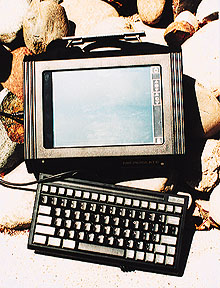Microslate Datellite 500PA 133/166MMX Pentium makes Microslate's ultra-rugged Datellite one of the fastest pen computer available on the market today Like the other rugged pen computer reviewed in this issue--the
Kalidor K2500--the Microslate Datellite 500P is an evolutionary rather than a
revolutionary product, an updated version of a tried and true machine. However, this
latest offering by the innovative Microslate people from Brossard in the Canadian province
of Quebec also represents a milestone in pen computing technology. A year and a half ago we reviewed the Microslate Datellite 400L and called it the "military spec 800 lbs. gorilla of field computers." Nothing has changed in that general area. The 500P still has the same blunt and utilitarian "lunchbox" design, it's still as rough and tough, and its voluminous case still offers plenty of space for internal expansion. Microslate has always walked to the beat of a different drummer, and they saw no reason to change. Neither do we.
While speed is the big news, Microslate's latest retains all the characteristics of its predecessors. The voluminous 12.65 x 10 x 2.65 inch lunch bucket design provides plenty of space inside and even includes full size expansion connectors, somewhat of a rarity these days. On the left side are serial, parallel, and video ports, an external drive adapter, a keyboard port, and an RJ11 jack for the internal 28.8 or CDPD modem. The right side contains a cavernous PC Card bay, a sturdy on/off switch, and an infrared window. The ports on both sides are covered and protected by rubber boots almost the size of galoshes. The black housing is made of seemingly invulnerable plastic. Everything is fully gasketed and sealed, and all internals are shock-buffered. The metal-hinged handle looks like it's designed for the biggest Samsonite. This is a serious computer. Inside, the Datellite 500P remains highly customizable, with room for a GPS receiver, additional ports, many wireless options, and just about anything else on the market. If it exists, it'll fit inside the 500P. People who need a lot of disk space will love the 500P. Apart from the standard 1.4GB drive, there are 2.1 and 3.4GB gigabyte options, and you can have two internal hard disks. Despite its size, the Datellite weighs in at a modest six pounds (seven with the optional second 1.4 amp/hour battery), less than most full function notebook PCs. The Datellite's optional keyboard, by the way, is one of the best we've seen available for pen tablets. It is full size yet compact and offers very good tactile feedback. It's also nicely color coordinated with the 500P. Sort of a beauty and the beast combination. Unlike earlier Datellites, the 500P also has full sound capabilities. It has onboard Sound Blaster Pro 16-bit compatible sound circuitry, a surprisingly good internal speaker, and stereo in/out plugs through an 80-pin docking connector. As far as operating systems go, the 500P supports CIC's PenDOS, PenRight!, Windows 3.11, and Windows 95. Support for OS/2 Warp with Pen Extensions is also available. Like earlier versions of the Datellite, the 500P also comes with Microslate's KeySlate pop-up keyboard, the MenuSlate touch screen menu system, and LinkSlate remote disk access software. MicroSlate's OmniSuspend power management program is also carried over and provides various states of power conservation. Another advantage of the Datellite's size is that there is room for a large screen. The standard screen uses backlit transflective LCD technology and measures 9.4" diagonally. The resistive digitizer has tempered glass or polycarbonate backing and uses MicroSlate's famous $2 pens made by, who else, BIC. Optionally available is a 10.4" 800 x 600 pixel active matrix color screen. It's amazing how quickly we all have become accustomed to large, bright color screens, especially with Windows 95 being so color-orientated. As a result, monochrome and grayscale screens look less and less impressive all the time. That, in a nutshell, is the MicroSlate Datellite 500P. It is a rough-tough workhorse of a field computer that also happens to be one of the fastest pen computer around.
| ||||||||||||||||||||||||||
[Features] [Showcase] [Developer] [Members] [Subscribe] [Resources] [Contacts] [Guidelines] All contents ©1995-1998 Pen
Computing Magazine, Inc. All rights reserved. |




 The
only problem with the previous Datellite 400L was that its rather anemic Cyrix 486SLC
processor simply couldn't back up the bark of the unit's aggressive exterior. This has now
changed. Microslate's gorilla received a very serious power boost and now ripples with 133
or 166Mhz of raw Pentium muscle. This makes the Datellite 500P one of the one of the
fastest Pentium-based pen tablets on the market and all but assures it a leading position
as a prime contender in the high performance field application stakes.
The
only problem with the previous Datellite 400L was that its rather anemic Cyrix 486SLC
processor simply couldn't back up the bark of the unit's aggressive exterior. This has now
changed. Microslate's gorilla received a very serious power boost and now ripples with 133
or 166Mhz of raw Pentium muscle. This makes the Datellite 500P one of the one of the
fastest Pentium-based pen tablets on the market and all but assures it a leading position
as a prime contender in the high performance field application stakes.